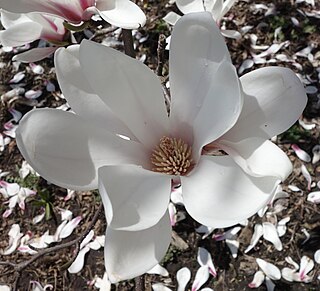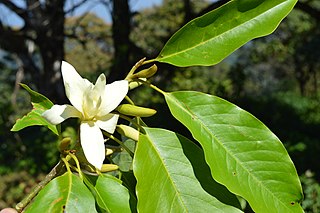
The Magnoliaceae are a flowering plant family, the magnolia family, in the order Magnoliales. It consists of two subfamilies: Magnolioideae, of which Magnolia is the best-known genus, and Liriodendroidae, a monogeneric subfamily, of which Liriodendron is the only genus.

Magnolia is a large genus of about 210 flowering plant species in the subfamily Magnolioideae of the family Magnoliaceae. It is named after French botanist Pierre Magnol.

Magnolia virginiana, most commonly known as sweetbay magnolia, or merely sweetbay, is a member of the magnolia family, Magnoliaceae. It was the first magnolia to be scientifically described under modern rules of botanical nomenclature, and is the type species of the genus Magnolia; as Magnolia is also the type genus of all flowering plants (magnoliophytes), this species in a sense typifies all flowering plants.

Michelia is a historical genus of flowering plants belonging to the Magnolia family (Magnoliaceae). The genus included about 50 species of evergreen trees and shrubs, native to tropical and subtropical south and southeast Asia (Indomalaya), including southern China. Today it is regarded as a synonym of Magnolia.

Magnolia hodgsonii, known in Chinese as gai lie mu is a species of Magnolia native to the forests of the Himalaya and southeastern Asia, occurring in Bhutan, southwestern China (Xizang), northeastern India, northern Myanmar, Nepal, and Thailand. It grows at moderate altitudes of 850–1500 m with a subtropical climate.

Magnolia amoena is a species of plant in the family Magnoliaceae. It is endemic to China. It is threatened by habitat loss.
Magnolia boliviana is a tree in the family Magnoliaceae native to the rainforests of the eastern Andean foothills of Bolivia.

Magnolia cylindrica, the Huangshan magnolia, is a species of plant in the family Magnoliaceae. It is endemic to China. It is threatened by habitat loss.

Magnolia dealbata is a species of flowering plant in the family Magnoliaceae. It is known commonly as the cloudforest magnolia and eleoxochitl. It is sometimes considered to be a subspecies of Magnolia macrophylla.

Magnolia rostrata, the beaked magnolia, is a species of plant in the family Magnoliaceae. It is found in the Himalayas. It is an IUCN Red List endangered species, threatened by habitat loss.
Magnolia virolinensis is a species of plant in the family Magnoliaceae. It is endemic to Colombia.
Magnolia wolfii is a tree species in the family Magnoliaceae. It is endemic to Colombia. The species is recorded only from one locality in Risaralda Department. The species is being investigated by a conservation and propagation research program implemented by the Technological University of Pereira, with the support of Botanic Gardens Conservation International.
Magnolia dixonii is a species of flowering plant in the family Magnoliaceae. It is endemic to Ecuador. It is known commonly as cucharillo.

Talauma is sometimes treated as a genus of plant in family Magnoliaceae. In modern literature, however, it is often treated as section Talauma in subgenus Magnolia of genus Magnolia. It contains only New World species. For all species in this taxon, names in Magnolia are available.

Llanganates National Park is a protected area in Ecuador situated in the Cotopaxi Province, Napo Province, Pastaza Province and Tungurahua Province. Located within the park is Cerro Hermoso, a 4570 meter high peak that is a popular hiking destination. The park is famous for the Treasure of the Llanganatis.
Magnolia poasana is a sub-tropical to tropical, subcanopy tree, growing in areas of montane rainforest. The names "Poas", and "poasana" originate from the Poás Volcano in Costa Rica where, along with Panama, they grow in the wild. First described by Henri François Pittier in 1910, it was later described and included in Magnolia by James Edgar Dandy (1927).
Magnolia amazonica is a flowering evergreen tree of the family Magnoliaceae native to the lower western Amazon River Basin, including Peru and Brazil.
Magnolia rimachii is a small to medium-sized tree of the family Magnoliaceae commonly reaching 8 to 15 m high. It is found in the western lowland Amazon Basin tropical forest, in Ecuador and Peru, between 140–500 metres (460–1,640 ft) in elevation.

Magnolia liliifera, commonly known as egg magnolia, is a flowering tree native to the Indomalayan realm. It bears white to cream-colored flowers on terminal stems. The leaves are elliptical and get as large as 25 cm (10 in) long and 8 cm (3 in) wide. The tree ranges in height from 3.5 to 18.5 m in situ.

Magnolia nilagirica is a species of plant in the family Magnoliaceae. It is a tree that is threatened by habitat loss, endemic to the Western Ghats of India, and also Sri Lanka.













